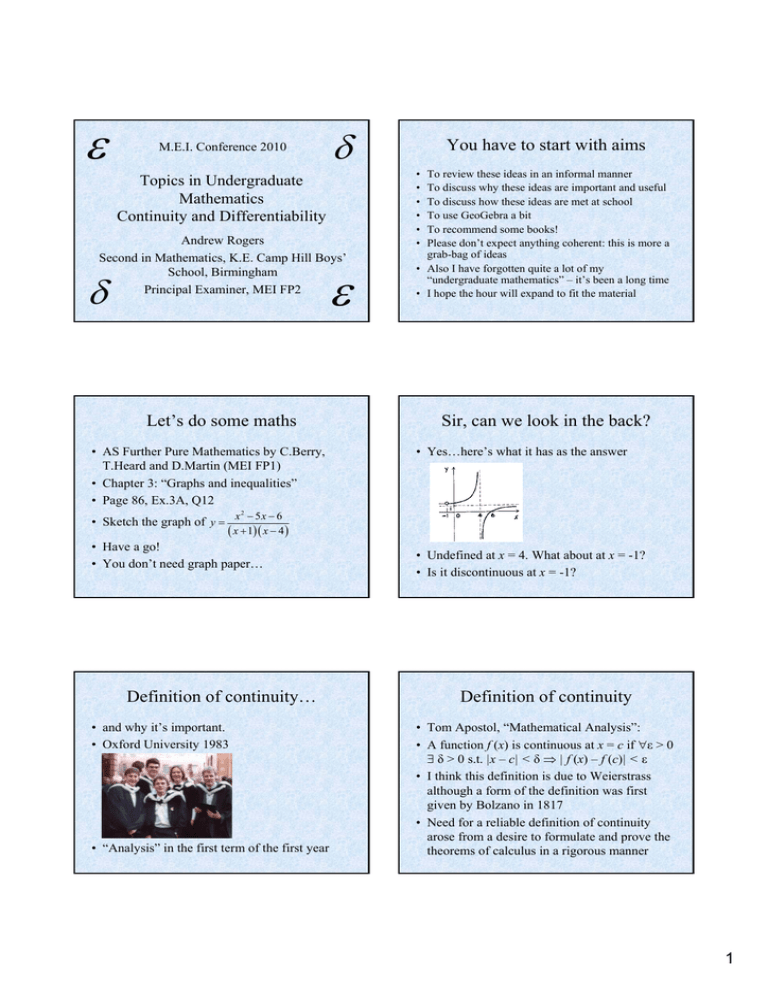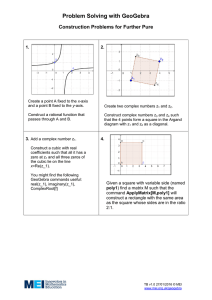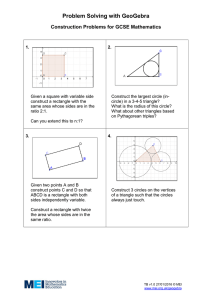ε δ You have to start with aims Topics in Undergraduate
advertisement

ε
δ
M.E.I. Conference 2010
Topics in Undergraduate
Mathematics
Continuity and Differentiability
Andrew Rogers
Second in Mathematics, K.E. Camp Hill Boys’
School, Birmingham
Principal Examiner, MEI FP2
ε
δ
Let’s do some maths
• AS Further Pure Mathematics by C.Berry,
T.Heard and D.Martin (MEI FP1)
• Chapter 3: “Graphs and inequalities”
• Page 86, Ex.3A, Q12
• Sketch the graph of y =
You have to start with aims
•
•
•
•
•
•
To review these ideas in an informal manner
To discuss why these ideas are important and useful
To discuss how these ideas are met at school
To use GeoGebra a bit
To recommend some books!
Please don’t expect anything coherent: this is more a
grab-bag of ideas
• Also I have forgotten quite a lot of my
“undergraduate mathematics” – it’s been a long time
• I hope the hour will expand to fit the material
Sir, can we look in the back?
• Yes…here’s what it has as the answer
x2 − 5x − 6
( x + 1)( x − 4 )
• Have a go!
• You don’t need graph paper…
Definition of continuity…
• and why it’s important.
• Oxford University 1983
• “Analysis” in the first term of the first year
• Undefined at x = 4. What about at x = -1?
• Is it discontinuous at x = -1?
Definition of continuity
• Tom Apostol, “Mathematical Analysis”:
• A function f (x) is continuous at x = c if ∀ε > 0
∃ δ > 0 s.t. |x – c| < δ ⇒ | f (x) – f (c)| < ε
• I think this definition is due to Weierstrass
although a form of the definition was first
given by Bolzano in 1817
• Need for a reliable definition of continuity
arose from a desire to formulate and prove the
theorems of calculus in a rigorous manner
1
Just to confuse the issues…
No, we didn’t get it either.
• We also had in the first year:
• the limit definition: f (x) is continuous at x = c
if ∀ sequences xn → c, f (xn) → f (c)
• the topological definition: if f : X → Y where
X and Y are topological spaces, f is continuous
if and only if ∀ open sets V ⊆ Y, f -1(V) =
{x ∈ X| f (x) ∈ V} is open.
• Are you with me?
Brief survey of where it comes now
• it = continuity of functions
• Oxford: First year, Hilary Term (Analysis II)
• Warwick: First year, first and second terms
(MA131 Analysis)
• Durham: First year, all year (Core B1)
• Birmingham: Second year
Infinitesimals under attack!
It is important
• The ideas of continuity and limit underpin the
differential calculus
• Basic ideas: Newton and Leibnitz of course!
• They used infinitesimals
• Archimedes had discussed infinitesimals in his
Method of Mathematical Theorems:
• x is infinite if |x| > 1, |x| > 1 + 1, |x| > 1 + 1 + 1…
• and infinitesimal if x ≠ 0 and a similar set of
conditions holds for 1/x and reciprocals of positive
integers
Infinitesimals under attack!
• Bishop George Berkeley (1685-1753), Bishop of
Cloyne, Ireland
• In 1734 Bishop Berkeley published The Analyst, or A
Discourse Addressed to an Infidel Mathematician
2
Infinitesimals survive
Mathematical Interlude
• Infinitesimals continued to be used to produce
correct results
• Calculus was given a formal mathematical
foundation by Weierstrass and others using the
idea of a limit
• In the 20th century it was found that
infintesimals could be treated rigorously, e.g.
the work of Abraham Robinson (1918-1974) in
non-standard analysis
• But let’s not go there.
• How would you find the derivative of f (x) = 2x
at x = 0 from first principles? Discuss…
• Let’s use Excel to investigate!
• Oh dear!
• Try h = 10-12 on a Casio fx-83ES
• Isn’t this “small”?
• Aside: may I commend to you the MEI
Numerical Methods unit
• In MEI FP1, x = 100 is officially “large”
What is a limit?
How to annoy small children
• The task of finding lim f ( x )
x →0
is the same as finding a number L such that if
you place a dot at (0, L), the parts of the graph
of y = f (x) for x > 0 and x < 0 are joined up, so
the resulting graph is smooth or continuous
across the vertical line through (0, L).
• Compare this with those εs and δs…is this
“better”?
• There is a problem…
• There are NO numbers “either side” of zero!
• Ask Year 7 “What is the smallest number
larger than zero?”
• Principle of Trichotomy: given two numbers
a and b, then a = b or a < b or a > b. (True?)
• Suppose x ≠ 0 is “next to” 0. Then x < 0 or > 0.
• Either way, x/2 is closer to 0 than x.
• Oh dear…
Professor E. McSquared
What about the function we started
with?
• If I had had this book while at university, I
would have understood what all those epsilons
and deltas were doing much more easily
• It would be a good acquisition for any school
library
• It is available direct from the publishers
• I am not on commission from them
• Another formulation is
• f ( x ) = x − 6 if x ≠ -1
x−4
• and undefined if x = -1.
• From the graph, it certainly looks like f (x)
wants to be 1.4 if x = -1.
• So let f ( x ) be f (x) if x ≠ -1, and 1.4 if x = -1.
• Now we prove that f ( x ) is continuous at -1.
3
Typing into PowerPoint
• is not easy.
• So I have a handout.
• Please tell me if it’s wrong. This is the first
epsilon/delta proof I’ve done for probably 22
years…
School Mathematics
• How relevant is all this to school maths?
• When do pupils first meet:
– infinity?
– discontinuous graphs?
– limits and convergence?
• What do pupils think undergraduate maths is
all about?
Questions about infinity
• Quote from Year 7: “Sir, can we do infinity today?”
• G.H.Hardy (A Course of Pure Mathematics, 1908):
Countable and uncountable sets
• Graeme Segal, Oxford 1983
– The class of British subjects is a finite class
– The class of positive integers is not finite but infinite
• Are there more integers than positive integers?
• Yes…so ∞ = 2∞ + 1 ⇒ ∞ = -1?
• Are there more “decimals between 0 and 1” than
integers?
• “Good and bad” kinds of infinity
Discontinuous graphs
• Year 8? y = 1/x
• Year 10? y = 1/(x – 3) (translations)
• Year 10/11? y = tan x
• FP1 text p.93: y =
• Decision 1 W08: f (x) = [x]
x+2
( x − 2 )( x + 1)
• Approaching x-axis from “above” or “below”
• FP1 text p.86: y =
Discontinuous graphs
x−3
( x − 4)
2
• Core 3 and Numerical Methods: do we
consider whether a graph is discontinuous
when we use the change of sign method to
locate a root?
• “Double” asymptote
4
Limits
AQA FP3
• y = 1/x as x → ∞: when considered?
• An intuitive idea is easy, but what do we really
mean by “x → ∞”?
• f (x) → l as x → ∞ if ∀ k, ∃ x0 s.t. | f (x) – l| < k
∀ x > x0
• “Formal” limits: differentiation from first
principles (Add Maths Year 11/Year 12?)
• “Limiting Processes”: option in MEI P6. In
other A level Further Maths specifications?
S.M.P. Further Maths (-1996)
•
S.M.P. Extensions of Calculus, C.Goldsmith
& D.Nelson
3x 2 + 2 x
(1) Consider the graph of y =
x−9
•
Have a go?
3
∫x
−1
−2
Oblique asymptotes
• Argument in the text goes like this
• y = 3x + 29 +
261
x−9
• y = 3x + 29 +
261
x
9
x
1−
• As x → ∞, the top → 0 and the bottom → 1
• It follows that y = 3x + 29 is an asymptote
• So can we say that y → 3x + 29 as x → ∞?
(2) Improper integrals
•
• W09 Q6
3
dx = ⎡⎣ ln x ⎤⎦ −2 = ln 3 − ln 2 = 0.405...?
Do we still do these things?
• MEI Statistics 3, W08, Q1(a)
• No! Core 3: ∞ - ∞ = 0.405…
• But
u
• ∫ x−
− 23
dx exists. Why?
−1
2
3
−1
8
8
∫x
u
dx = ⎡3 x 3 ⎤ = 3u 3 + 3 →
⎣ ⎦ −1
1
8
1
3 as u → 0 from below
• ∫ x − dx = ⎡⎣3x ⎤⎦ u = 6 − 3u → 6 as u → 0 from above
u
2
3
1
3
1
3
• so the value of the integral is 9
5
Convergence of sequences/series
Some software
• Year 7: intuitive ideas: Zeno’s paradox, etc.
Recurring decimals: 0.9 recurring = 1? (What’s the
difference? “Infinity of zeros and then 1”)
• GCSE: “formal” proof that e.g. 4/11 = 0.36 recurring
• Year 12: Core 2, Sequences and Series: Freddie the
Frog
• Year 13: Core 4: Binomial theorem for n not a
positive integer. FP2: Maclaurin series. S2:
motivating the Poisson distribution by using the
expansion of ex
• Oxford Interview 1982: bouncy ball, coefficient of
restitution 0.6…does it stop?
• GeoGebra is amazing but I don’t know how to
use it properly yet
• I’m going to try to use it to illustrate some
“Hennings Functions”
• Actually Chris Sangwin did it for me
• There is a whole strand on GeoGebra at this
conference
• You can probably do a lot of this on
AutographTM
Hennings functions
Hennings function #1
• When we were at university, we were taught by a
brilliant young Junior Research Fellow, Mark
Hennings
• He went on to be admissions tutor at Sidney Sussex,
Cambridge, but was last heard of teaching at Rugby
School
• He solves the hard problems in the Mathematical
Gazette
• I can’t find a picture of him
• Tutorials could be frightening. He used to destroy our
“proofs” by producing “Hennings functions”
Hennings function #2
• This illustrates the function
( )
n
sin r 2 x
r =1
r2
fn ( x ) = ∑
• This illustrates the function
nx
1 ⎞
⎛
f ( x ) = ⎜1 + x ⎟
⎝ n ⎠
• Chris Sangwin did it on GeoGebra for me
x/n
1
2
5
10
20
30
0
2
2
2
2
2
2
5
2
2.67699
2.717847 2.718268 2.718281 2.718282
10
2
2.716956 2.718282 2.718282 2.719489 2.854569
20
2
2.718281 2.705438
1
1
1
30
2
2.718282
1
1
1
1
A sum of smooth things can be crinkly
• Weierstrass thought of one as well. The paper
on the next page looks like it’s advertising a
Victorian circus act.
• and the spreadsheet capability of GeoGebra
• Again, Chris showed me how to do it
• It’s very crinkly. Zoom in. I think as n gets
bigger it tends to a function which is
continuous everywhere, but differentiable
nowhere
6
Weierstrass’ non-differentiable function
Further reading
• Wikipedia for some of the history!
• http://www.maths.tcd.ie/pub/HistMath/People/Berkeley/Analy
st/Analyst.pdf
• “Understanding Infinity” by Tony Gardiner
• “Using Counter-examples in Calculus” by John Mason and
Sergiy Klymchuk
• “A Course of Pure Mathematics” by G.H.Hardy
• Various school textbooks (sometimes the older the better, e.g.
SMP Further Maths and things by Durell and Porter)
• and, of course, Professor E. McSquared’s Calculus Primer
(Expanded Intergalactic Version)
• http://www.math.sjsu.edu/~swann/mcsqrd.html
• and “The Theory of Differential Calculus” by Howard Swann
(internet download)
48 slides in 60 minutes?
• Thank you for watching!
• I thoroughly enjoyed preparing this: it brought
back many memories, most of them good
• I would like to thank Dr. Chris Sangwin of the
University of Birmingham for many ideas
• amrogers1@gmail.com
7
Topics in Undergraduate Mathematics: Continuity and Differentiability
An attempt at a proof that f (x) =
x−6
(x ≠ −1), 1.4 (x = −1) is continuous at x = −1.
x−4
What we want is to find a δ(ε) such that
x−6
x + 1 < δ(ε) ⇒ 1.4 − ε <
< 1.4 + ε
x−4
x−6
− 1.4 < ε
⇒
−ε <
x−4
x − 6 − 1.4 ( x − 4 )
<ε
⇒
−ε <
x−4
−0.4 ( x + 1)
⇒
−ε <
<ε
x−4
0.4 ( x + 1)
⇒
<ε
x−4
Suppose δ(ε) < ½. Then x + 1 < ½ and
⇒
⇒
⇒
⇒
−½ < x + 1 < ½
−1.5 < x < −0.5
−5.5 < x − 4 < −4.5
4.5 < x − 4
0.4 ( x + 1)
x−4
<
0.4 x + 1
4.5
=
4 x +1
45
.
1 45
So if we take δ(ε) = min{ ,
ε }, we can guarantee that
2 4
0.4 ( x + 1)
x + 1 < δ(ε) ⇒
<ε
x−4
⇒
Phew!
1.4 − ε <
x−6
< 1.4 + ε, which is what we wanted.
x−4



